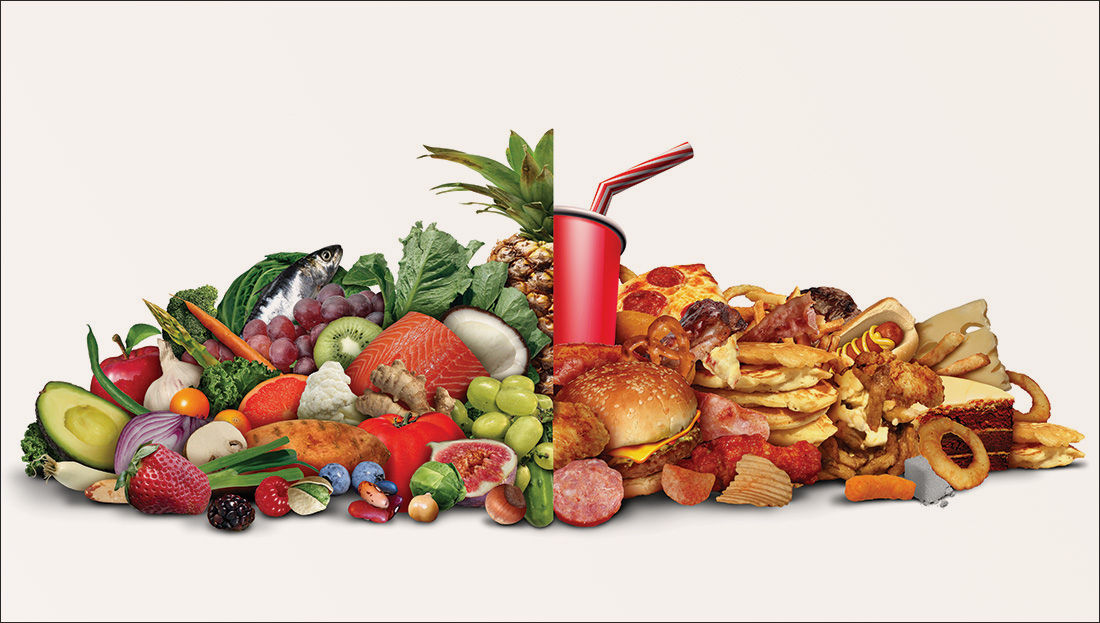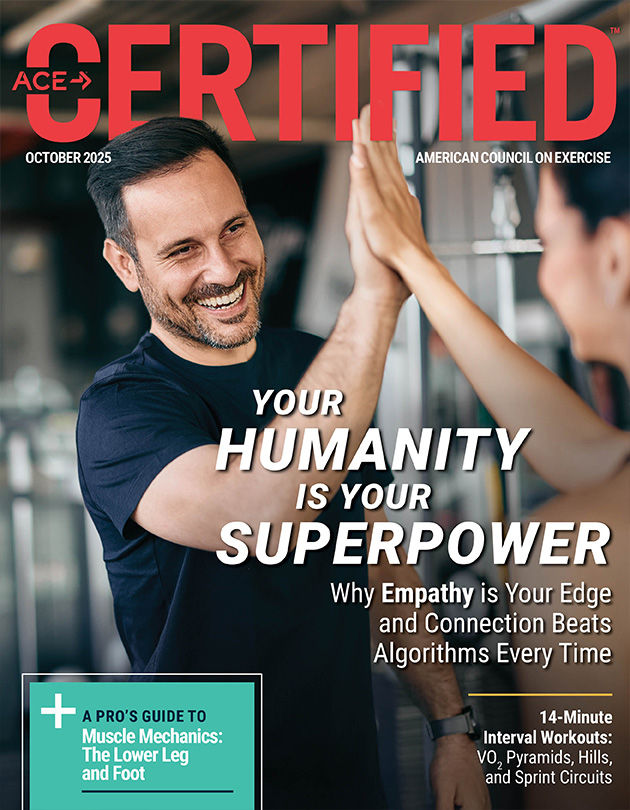
Unpacking the Ultra-processed Food Problem: What Health and Exercise Professionals Need to Know

For years, nutrition guidance has emphasized what we eat and prioritized nutrients like fiber, protein, sugar and saturated fat. But a growing body of research now points to something more nuanced: How our food is made may be just as important as what’s in it. This shift in focus from nutrients to processing is backed by new findings that should be on the radar of every health and exercise professional.
Two major publications released in 2025 highlight the profound impact that ultra-processed foods (UPFs) have on health, particularly in relation to weight management and cardiometabolic outcomes. Together, these studies offer not only compelling data but also a roadmap for how we, as practitioners, can better educate and guide our clients toward long-term health improvements.
A New Layer of Understanding
The term “ultra-processed foods” refers to industrially formulated products that typically contain ingredients not found in home kitchens. These include sweeteners, emulsifiers, colorings and stabilizers, all designed to increase shelf life, improve palatability and make them more convenient. Things like soda, packaged snacks, reconstituted meats, ready meals and shelf-stable desserts are the most recognizable UPFs, and they now make up more than half of daily caloric intake for most American adults.
While observational research has long connected high UPF intake with poor health outcomes, the new randomized clinical trial conducted by the University College London (UCL) provides the strongest evidence to date that the processing itself—not just the nutritional profile—may matter.
In the study, 55 adults with overweight or obesity followed two eight-week dietary interventions: one featuring minimally processed foods (MPFs) and the other centered around UPFs. Both diets were designed to meet the UK’s Eatwell Guide recommendations for macro- and micronutrients, and participants were free to eat as much or as little as they liked.
Even though the two diets were nutritionally similar, participants lost nearly twice as much weight on the minimally processed plan. Importantly, this weight loss came predominantly from fat mass rather than muscle, suggesting improvements in body composition as well as overall weight.
What the Science Is Really Saying
At first glance, the results may seem surprising. After all, both diets contained the same levels of proteins, fibers, fats, carbohydrates and salt. Yet the outcomes were meaningfully different, not just in weight loss, but also in subjective appetite control, satiety and reductions in food cravings.
Participants reported feeling more satisfied, less driven to overeat and better able to control food-related impulses while eating minimally processed foods. In contrast, the ultra-processed diet, despite offering identical nutrients on paper, left individuals hungrier and more likely to consume excess calories.
These effects go beyond personal willpower. Researchers believe that the differences stem from how food structure, texture and ingredient composition influence digestion, gut microbiota, hormone signaling and neurological pathways related to hunger and reward.
“Not all ultra-processed foods are inherently unhealthy based on their nutritional profile,” explains Dr. Samuel Dicken, lead author of the UCL study. “The main aim of this trial was to fill crucial gaps in our knowledge about the role of food processing in the context of existing dietary guidance.” The results, he says, make it clear that food processing should be included in future dietary recommendations alongside traditional nutrient-based guidelines.
The Bigger Picture: Cardiometabolic Risk
While the clinical trial focused primarily on weight and body composition, the science advisory from the American Heart Association (AHA) widened the lens to include cardiovascular and metabolic health. According to the advisory, UPFs—particularly those high in saturated fats, added sugars and sodium (sometimes abbreviated as HFSS)—have been linked to a wide range of health risks, including hypertension, stroke, obesity, type 2 diabetes and even premature death.
The AHA report also notes that more than 70% of grocery store items in the U.S. contain at least one ultra-processed ingredient. This figure underscores how challenging it can be for clients to navigate the modern food environment, especially when many UPFs are disguised as healthy through clever marketing, added vitamins or plant-based claims.
Dr. Maya Vadiveloo, who chaired the AHA advisory committee, emphasizes that the issue isn’t simply about demonizing processed foods. “We know that eating foods with too much saturated fat, added sugars and salt is unhealthy,” she says. “What we don’t know is if certain ingredients or processing techniques make a food unhealthy above and beyond their poor nutritional composition.” Her group calls for more research into the health effects of additives, emulsifiers and preservatives, many of which are common in UPFs but rarely studied in isolation.
Complexity and Confusion: Not All UPFs Are the Same
An important nuance in both the trial and the AHA advisory is the recognition that not all UPFs are equally harmful. Some foods that technically fall under the UPF category—such as whole-grain breads with minimal additives, plain yogurts or fortified plant-based milks—can support a healthy diet, particularly for individuals with limited access to fresh, whole foods.
This creates confusion for clients and even health and exercise professionals. The Nova classification system, which is commonly used to categorize food processing levels, is based primarily on processing techniques and additives, not nutrient quality. As a result, health-promoting foods can sometimes be grouped in the same category as energy-dense junk foods.
For that reason, both publications advocate for a more nuanced approach to dietary guidance, one that discourages excessive consumption of nutrient-poor UPFs without needlessly restricting foods that are affordable, accessible and nutritionally sound.
Applying the Science to Your Work With Clients
As a health and exercise professional, how can you use this information to better support your clients?
First, shift the conversation away from rigid rules and toward education. Clients often assume that healthy eating requires perfection or expensive organic foods. Instead, help them understand that focusing on food quality—particularly choosing less processed options—can have a meaningful impact, even without counting calories.
Encourage clients to prepare more meals at home using whole ingredients whenever possible. Even modest changes, such as swapping out breakfast pastries for overnight oats or replacing a frozen entrée with a simple stir-fry, can lead to noticeable improvements in how they feel and how they eat throughout the day.
Label education is also essential. Rather than focusing only on macronutrients, teach clients to scan ingredient lists for signs of extensive processing. Products with long ingredient lists, unfamiliar names or items not typically found in a home kitchen are more likely to be UPFs. This awareness can empower clients to make informed choices without becoming overwhelmed or obsessive.
Just as important is helping clients navigate the emotional and behavioral aspects of food. Many UPFs are designed to be hyper-palatable and easy to overconsume, particularly during times of stress or emotional vulnerability. By working with clients to identify patterns of emotional eating and develop alternative coping strategies, you can help them reduce reliance on these foods in a sustainable and supportive way.
Final Thoughts
The latest research underscores something that many health and exercise professionals have observed firsthand: Not all calories are created equal, and not all “healthy” diets produce the same results. When clients switch from ultra-processed meals to more whole, minimally processed foods, even when calories and macros are similar, they often feel fuller, lose more fat and improve their overall relationship with food.
These insights open the door to more effective coaching strategies—those that emphasize food experience, satisfaction and sustainability over strict nutrient calculations. As Dr. Dicken says, “Choosing minimally processed foods may be more effective for losing weight, even when observing dietary guidelines.”
By staying informed about the science of food processing and sharing this knowledge in an accessible, nonjudgmental way, you can help your clients navigate the modern food environment with greater clarity and confidence, and ultimately, guide them toward improved health and well-being that lasts.

More Articles
- Certified™: October 2025
14-Minute Interval Workouts: VO2 Pyramids, Hills and Sprint Circuits
Health and Fitness Expert
- Certified™: October 2025
Fit Together: Coaching Strategies for Couples, Friends and Siblings
Contributor
- Certified™: October 2025
A Pro’s Guide to Muscle Mechanics: The Lower Leg and Foot
Health and Fitness Expert




 by
by 

